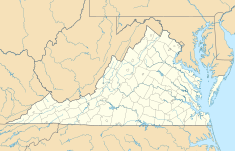Bath County Pumped Storage Station facts for kids
Quick facts for kids Bath County Pumped Storage Station |
|
|---|---|
|
Location of Bath County Pumped Storage Station in Virginia
|
|
| Country | United States |
| Location | Bath County, Virginia |
| Coordinates | 38°13′50″N 79°49′10″W / 38.23056°N 79.81944°W |
| Purpose | Power |
| Status | Operational |
| Construction began | March 1977 |
| Opening date | December 1985 |
| Construction cost | US$1.6 billion (in 1985 dollars); US$3.82 billion (in 2019 dollars) |
| Owner(s) | Dominion Generation (60%) LS Power (40%) |
| Dam and spillways | |
| Type of dam | Embankment dam |
| Height (foundation) | 460 feet (140 m) |
| Length | 2,200 feet (670 m) |
| Dam volume | 18,000,000 cubic yards (14,000,000 m3) |
| Reservoir | |
| Total capacity | 35,599 acre-feet (43,911,000 m3) |
| Surface area | 265 acres (107 ha) |
| Power station | |
| Name | Power Station |
| Coordinates | 38°12′32″N 79°48′00″W / 38.20889°N 79.80000°W |
| Commission date | December 1985 |
| Type | Pumped-storage |
| Hydraulic head | 1,262 feet (385 m) |
| Installed capacity | 3003 |
| Annual generation | -935 |
| Website Bath County Pumped Storage Station Website |
|
The Bath County Pumped Storage Station is a special kind of power plant that uses water to store and create electricity. It's often called the "largest battery in the world"! This huge station can make up to 3,003 megawatts (MW) of power. It can also store a massive 24,000 megawatt-hours (MWh) of energy.
This amazing power plant is located in the northern part of Bath County, Virginia. It sits near the border between Virginia and West Virginia. The station uses two large lakes, called reservoirs, that are about 1,260 feet (380 m) apart in height. This difference in height is key to how it works.
Building this power station started in March 1977. It was finished in December 1985. The original cost was about $1.6 billion. Between 2004 and 2009, the station was updated. This made its power generation even stronger. The Bath County Station is owned by Dominion Generation (60%) and FirstEnergy (40%). It helps manage electricity for a large area across 13 states.
How it's Built
The Bath County Station has two main parts: an upper reservoir and a lower reservoir. These reservoirs are like big lakes. They are held in place by huge walls made of earth and rock, called embankment dams.
The upper reservoir dam is about 460 feet (140 m) tall and 2,200 feet (670 m) long. It holds a lot of water, enough to cover 265 acres (107 ha) of land. The lower reservoir dam is 135 feet (41 m) tall and 2,400 feet (730 m) long. It creates a lake that covers 555 acres (225 ha) of land.
To move water between these two reservoirs, there are three long tunnels. These tunnels are between 3,100–3,600 feet (940–1,100 m) long. Each tunnel leads to a 990 feet (300 m) deep shaft. From there, the water goes into two smaller pipes called penstocks. There are six penstocks in total. These pipes are about 18 feet (5.5 m) wide and can be up to 1,260 feet (380 m) long. They carry the water directly to the turbines.
How it Works
The Bath County Station works like a giant rechargeable battery. It stores energy using water.
When people need a lot of electricity, like during the day, water is released from the upper reservoir. This water rushes down through the tunnels and pipes. It spins giant turbines, which are like big fans. These turbines then create electricity. This is called generating power.
When people don't need as much electricity, like late at night, the station does the opposite. It uses extra power from other power plants, like those that use coal or nuclear energy. This extra power is used to pump water from the lower reservoir back up to the upper reservoir. This process stores energy for later.
Even though the plant uses some power to pump water back up, it helps other power plants work more efficiently. This saves money overall. The water in the reservoirs comes from small creeks. Since the water is mostly moved back and forth, only a small amount is needed to replace what evaporates. The water levels in the reservoirs change a lot during operation. The upper reservoir's water level can go up and down by over 105 feet (32 m). The lower reservoir's water level can change by about 60 feet (18 m).
When the station is making power, a huge amount of water flows: about 13.5 million US gallons (51,000 m3) every minute! When it's pumping water back up, it moves about 12.7 million US gallons (48,000 m3) per minute.
Nature and the Environment
The Bath County Station also helps the environment. A special fishing area was created downstream from the power plant.
During times when there isn't much rain, water quality in the creeks can be kept good. This is done by using water from nearby recreational lakes. These lakes and creeks have good quality water, which is important for fish and other wildlife.


